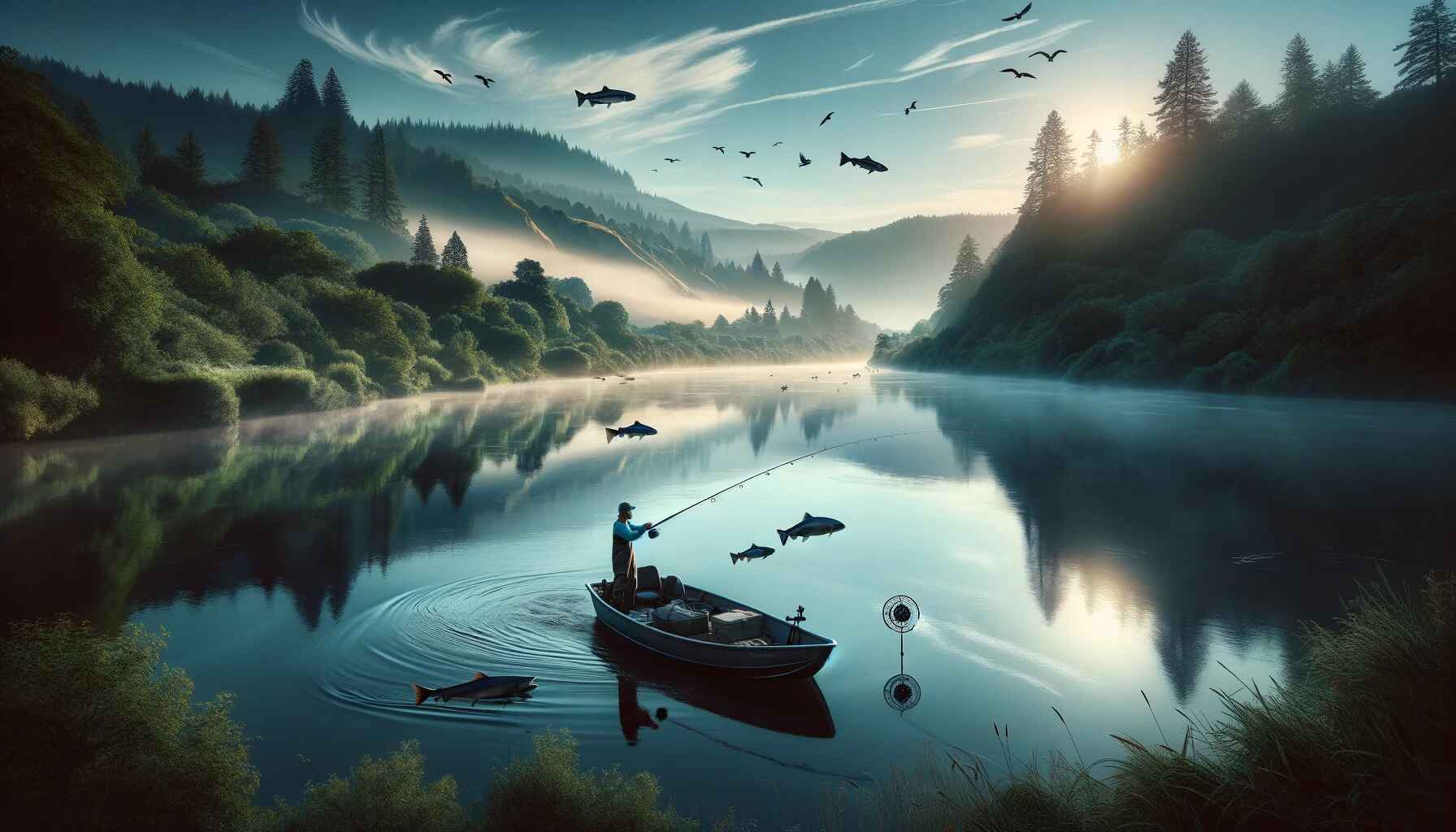The Willamette River in Oregon is renowned among anglers for its abundant steelhead population, offering a thrilling and rewarding fishing experience. Whether you’re a seasoned angler or a novice looking to try your hand at catching these elusive fish, understanding the nuances of steelhead fishing on the Willamette River is essential.
Understanding Steelhead
Before diving into the specifics of fishing on the Willamette River, it’s crucial to understand what makes steelhead unique. Steelhead are anadromous rainbow trout, meaning they spend part of their life cycle in freshwater before migrating to the ocean, where they grow rapidly before returning to freshwater to spawn. This dual life cycle presents anglers with an exciting challenge, as steelhead exhibit behaviors and characteristics distinct from resident rainbow trout.
The Willamette River: Prime Steelhead Habitat
The Willamette River, stretching over 300 miles through western Oregon, provides prime habitat for steelhead. Its cold, clean waters offer ideal conditions for these fish to thrive, with ample food sources and suitable spawning grounds. While steelhead can be found throughout the river, certain sections are particularly renowned for their abundance and accessibility to anglers.
Best Times to Fish
Steelhead fishing on the Willamette River is typically best during the fall, winter, and early spring months. This is when steelhead make their spawning runs from the ocean back to their natal streams. Peak fishing seasons can vary depending on factors such as water temperature, river conditions, and fish migration patterns. Anglers often find success during periods of higher water flow, which can trigger steelhead to migrate upstream.
Fall Season (September – November)
In the fall, as temperatures cool and rainfall increases, steelhead begin their upstream journey from the Pacific Ocean. This period offers excellent fishing opportunities as steelhead move through the lower reaches of the Willamette River. Targeting deep pools and riffles can yield success during this time, especially after a fresh rain when steelhead are more active.
Winter Season (December – February)
Winter is prime time for steelhead fishing on the Willamette River. As temperatures drop, steelhead continue their migration, concentrating in the mid to upper reaches of the river. Anglers often employ a variety of techniques, including drift fishing, nymphing, and swinging flies, to entice steelhead during the colder months. Paying attention to water temperature and flow rates can help determine optimal fishing locations.
Spring Season (March-May)
Spring marks the tail end of the steelhead run on the Willamette River. While fishing can still be productive during this time, steelhead may become more selective as they prepare to spawn. Anglers may encounter fresher, more aggressive fish early in the spring season before focusing on spawning activities. Practicing catch-and-release techniques during this critical period helps conserve steelhead populations for future generations.
Techniques and Strategies
Successful steelhead fishing on the Willamette River often requires a combination of skill, patience, and adaptability. Anglers employ various techniques and strategies based on river conditions, fish behavior, and personal preferences. Here are some popular methods for targeting steelhead on the Willamette River:
Drift Fishing
Drift fishing, also known as drift baiting or drift fishing with bait, involves presenting natural or artificial baits to steelhead as they hold in current seams, pools, and runs. Common baits include cured salmon eggs, sand shrimp, and prawns. Anglers use specialized rigs, such as drift floats or pencil weights, to control the depth and drift of their presentation. Drift fishing can be highly effective, especially in slower-moving sections of the river.
Nymphing
Nymphing is a popular fly fishing technique for targeting steelhead in the Willamette River. Anglers use weighted nymph patterns that imitate aquatic insects or juvenile fish, fishing them below the surface in riffles, seams, and deep pools. Euro nymphing techniques, which involve tight-line presentations and precise drifts, have gained popularity among steelhead anglers seeking a more dynamic approach. Experimenting with different nymph patterns and presentations can increase success rates.
Swinging Flies
Swinging flies for steelhead is a time-honored tradition on the Willamette River. Anglers use spey or switch rods to cast and swing streamer patterns across the current, mimicking the movement of injured or fleeing baitfish. Steelhead are known to aggressively strike swung flies, especially during the winter months when water temperatures are cooler. Mastering the art of the swing requires practice and finesse, but the rewards can be well worth the effort.
Centerpin Fishing
Centerpin fishing, popularized in the Pacific Northwest, is another effective technique for targeting steelhead on the Willamette River. Anglers use specialized centerpin reels mounted on long, flexible rods to achieve precise drifts and natural presentations. The free-spooling design of centerpin reels allows for extended drifts and better detection of subtle strikes. While centerpin fishing requires skill and experience, it can be highly rewarding for anglers seeking a more traditional approach.
Gear and Equipment
Choosing the right gear and equipment is essential for success in steelhead fishing on the Willamette River. From rods and reels to lines and terminal tackle, each component plays a crucial role in maximizing your chances of hooking into a trophy steelhead. Here’s a breakdown of essential gear for Willamette River steelhead fishing:
Rods and Reels
When selecting a rod for steelhead fishing on the Willamette River, consider factors such as length, action, and power. Longer rods, typically between 10 to 12 feet, provide better line control and mending capabilities, especially when fishing with techniques like drift fishing or swinging flies. Choose a rod with a moderate to fast action and sufficient backbone to handle the powerful runs of steelhead. Match your rod with a quality reel capable of holding ample lines and providing smooth drag performance.
Our pick
Plusinno Fishing Rod and Reel Combo: This combo includes a 10-foot rod with fast action and sufficient backbone, paired with a quality reel featuring smooth drag performance. It offers great value for both beginners and experienced anglers.
Lines and Leaders
For drift fishing and nymphing, opt for floating or intermediate sinking fly lines to achieve proper depth and drift control. Fluorocarbon leaders in the 8 to 12-pound range offer stealth and abrasion resistance when targeting wary steelhead. When swinging flies, consider using sinking-tip or full-sink fly lines to get your presentation down to the fish’s level. Leaders and tippet material should be matched to the size of your flies and fishing conditions.
Our Pick
Opt for the Scientific Anglers Air Cel Floating Fly Line, available in various weights suitable for steelhead fishing. Pair it with the SF Fluorocarbon Tippet Line for stealthy presentations and abrasion resistance. This combo ensures optimal depth control and presentation accuracy when targeting steelhead on the Willamette River.
Terminal Tackle
Stock up on a variety of hooks, weights, and indicators to customize your presentations based on river conditions and fish behavior. For drift fishing, use size 2 to 4 hooks paired with split shot or pencil weights to achieve the desired depth. Experiment with different colors and sizes of yarn or foam indicators to detect subtle strikes. When nymphing, carry an assortment of beadhead and non-beadhead nymph patterns in sizes 6 to 10 to match the prevalent insect species.
Our Pick
Stock up on a variety of terminal tackle with the RUNCL Fishing Terminal Tackle Box. This comprehensive kit includes a selection of hooks, split shot, and indicators, allowing you to customize your presentations based on river conditions and fish behavior. Its compact design makes it easy to carry and organize your tackle on the riverbank.
Accessories
Don’t forget to pack essential accessories such as polarized sunglasses, a quality landing net, forceps or hemostats for hook removal, and a waterproof fly box to organize your fly patterns. A wading staff can provide stability and assistance when navigating rocky or swift currents. Consider investing in a quality wading jacket or rain gear to stay comfortable and dry during inclement weather. Pack a thermos of hot coffee or tea to keep warm during those chilly early morning outings.
Find your essential accessories here.
Regulations and Conservation
Responsible angling practices are crucial for preserving the health and sustainability of steelhead populations in the Willamette River. Familiarize yourself with local fishing regulations and conservation measures to ensure compliance and minimize your impact on the ecosystem. Here are some key regulations and guidelines to keep in mind:
Fishing Regulations
Check the Oregon Department of Fish and Wildlife (ODFW) website or consult the current fishing regulations booklet for up-to-date information on steelhead fishing seasons, bag limits, and gear restrictions on the Willamette River. Special regulations may apply to specific sections of the river, so be sure to research the rules for your intended fishing location. Practice catch-and-release fishing whenever possible to conserve wild steelhead stocks and promote sustainable fisheries.
Conservation Efforts
Support organizations and initiatives dedicated to steelhead conservation and habitat restoration in the Willamette River watershed. Get involved in volunteer activities such as river cleanups, habitat enhancement projects, and monitoring efforts to help safeguard steelhead populations for future generations. Respect riparian habitats and sensitive spawning areas by avoiding trampling vegetation and minimizing disturbances during your fishing outings. Together, we can all play a role in preserving the natural beauty and biodiversity of the Willamette River ecosystem.
Statistic
According to data from the Oregon Department of Fish and Wildlife (ODFW), an average of around 20,000 to 30,000 adult steelhead return to the Willamette River basin annually for spawning. This statistic highlights the significance of the Willamette River as a prime steelhead fishing destination and underscores the importance of conservation efforts to maintain healthy steelhead populations. Including this statistic in the article can provide readers with valuable context and insight into the abundance of steelhead in the river.
Conclusion
Steelhead fishing on the Willamette River offers anglers a unique opportunity to connect with nature and experience the thrill of pursuing these iconic fish in their native habitat. By understanding the behaviors, techniques, and regulations associated with steelhead fishing, you can enhance your chances of success while contributing to the conservation and sustainability of this cherished resource.
Whether you’re casting flies on a misty winter morning or drifting bait through a scenic riffle, the Willamette River holds endless possibilities for memorable fishing adventures. So grab your gear, head to the river, and immerse yourself in the rich angling tradition that has captivated generations of steelhead enthusiasts. Tight lines and happy fishing!









